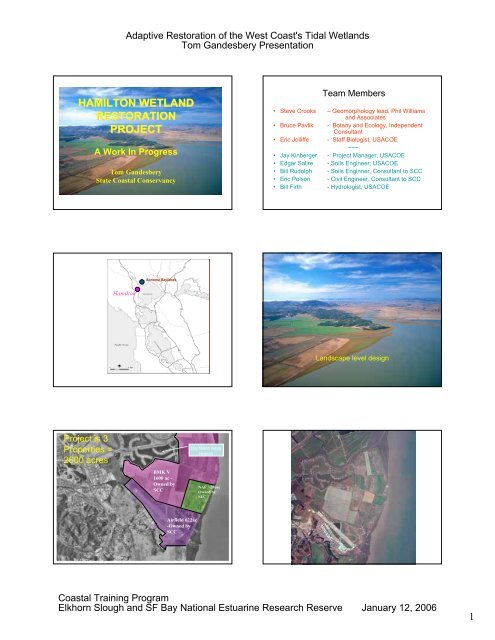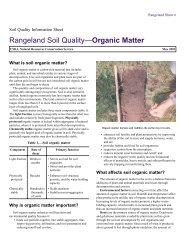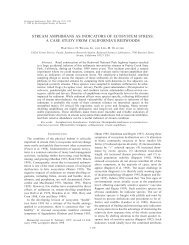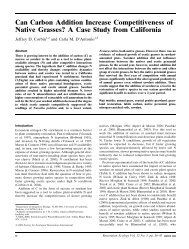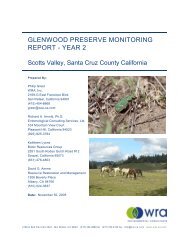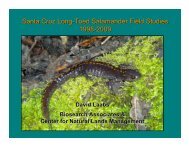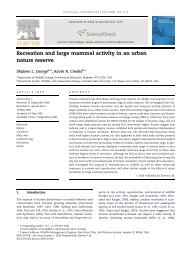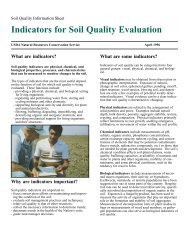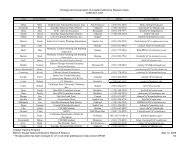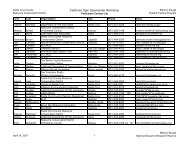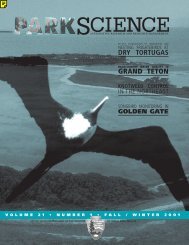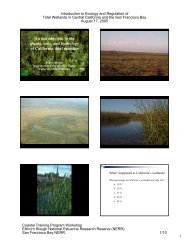hamilton wetland restoration project - the Elkhorn Slough Coastal ...
hamilton wetland restoration project - the Elkhorn Slough Coastal ...
hamilton wetland restoration project - the Elkhorn Slough Coastal ...
You also want an ePaper? Increase the reach of your titles
YUMPU automatically turns print PDFs into web optimized ePapers that Google loves.
Adaptive Restoration of <strong>the</strong> West Coast's Tidal WetlandsTom Gandesbery PresentationHAMILTON WETLANDRESTORATIONPROJECTA Work In ProgressTom GandesberyState <strong>Coastal</strong> ConservancyTeam Members• Steve Crooks – Geomorphology lead, Phil Williamsand Associates• Bruce Pavlik - Botany and Ecology, IndependentConsultant• Eric Jolliffe - Staff Biologist, USACOE~~~• Jay Kinberger - Project Manager, USACOE• Edgar Salire - Soils Engineer, USACOE• Bill Rudolph - Soils Enginner, Consultant to SCC• Eric Polson - Civil Engineer, Consultant to SCC• Bill Firth - Hydrologist, USACOESonoma BaylandsHamiltonLandscape level designProject is 3Properties =2600 acresBMK V1600 ac -Owned bySCCBel Marin KeysHomesNAF ~200acOwned bySLCAirfield 622ac-Owned bySCC<strong>Coastal</strong> Training Program<strong>Elkhorn</strong> <strong>Slough</strong> and SF Bay National Estuarine Research Reserve January 12, 20061
Adaptive Restoration of <strong>the</strong> West Coast's Tidal WetlandsTom Gandesbery PresentationFrom <strong>the</strong> NorthLTMS ~ Hamilton LinkPartners involved in:Pre-<strong>project</strong> planning (Since 1993)legislation (federal and state)Stakeholder Involvement (Local Govand NGO) = Collaboration (Workbetween agencies)Maritime Interest groupsHamilton Partners:California <strong>Coastal</strong> ConservancySan Francisco Bay Conservation &Development Commission (BCDC)U.S. Army Corps of EngineersLTMS StrategyLTMS Program EIS/EIR (1994) and ROD (1999)Disposal and Reuse Goal of 40/40/2020-Year Planning Horizon40% Ocean Disposal40% Reuse20% In-BayHow Will We Get There?Transition PeriodMillions of Cubic Yards/Year8.07.06.05.04.03.02.01.00.0Existing Disposal Limit Wet YearExisting Disposal Limit Dry YearCOEMediumSmall1999-2001 2002-2004 2005-2007 2008-2010 After 2010Multiple Objectives1. Marsh Restoration using Dredged Sediment( LTMS)2. Tidal Marsh Habitat benefiting Endangered Species North Bay Restoration Initiative (see map)Habitat LinkagesUSFWS / DGS Refuge System3. Well Planned Reuse of Military Lands BRAC No-Cost Conveyance to SCC(Hamilton)NorthBayProjectPotential<strong>Coastal</strong> Training Program<strong>Elkhorn</strong> <strong>Slough</strong> and SF Bay National Estuarine Research Reserve January 12, 20062
Adaptive Restoration of <strong>the</strong> West Coast's Tidal WetlandsTom Gandesbery PresentationDesign ObjectivesCreation of 3 habitat typestidal <strong>wetland</strong>sseasonal <strong>wetland</strong>suplandsTo benefit an array of speciesendangered (saltmarsh harvest mouse, clapper rail)shorebirds (e.g. greater yellowlegs, long-billed curlew)local wildlife (e.g. marsh hawk, voles, butterflies)With minimal long-term maintenanceHamilton Wetlands RestorationProjectAuthorized in WRDA 1999 - $55,200,000• Purpose: Ecosystem and Wetlands Restoration• Restores approximately 990 acres of habitat including:– 570 Acres of <strong>Coastal</strong> Salt Marsh– 120 Acres of tidal channels and intertidal habitats• Accommodates approximately 10.6MCY of dredgedmaterial• 13 years of Adaptive Management Post Breach• Complete Restoration – 20 YearsTotal ProjectConceptualDesign• Scan pdfRegardless of <strong>the</strong> availability of dredged material, <strong>the</strong> bayward levee breach would be completed no later than 8years after initiation of site preparation to ensure thatmarsh establishment would not be delayedBaylands BeforeAnd AfterPS Marina inbetter days<strong>Coastal</strong> Training Program<strong>Elkhorn</strong> <strong>Slough</strong> and SF Bay National Estuarine Research Reserve January 12, 20063
Adaptive Restoration of <strong>the</strong> West Coast's Tidal WetlandsTom Gandesbery PresentationHabitat Types at HamiltonHamilton Site TemplateHamilton Site at 10 YearsHamilton Site at 50 YearsTotal ProjectConceptualDesign• Scan pdfSummary of CostsTotal ProjectTotal Combined Cost……….……$281,400,000Federal ...………..…..$221,600,000Project Share………..……..$128,200,000O&M Share……………..……$76,900,000Oakland -50’ Project Share….$16,500,000Non-Federal..…………$59,800,000Sponsor Share…………..…..$42,800,000Non-Fed O&M Share………..$11,500,000Oakland 50’ Project Share…...$5,500,000Annual O&M (<strong>project</strong> life)……..$886,000<strong>Coastal</strong> Training Program<strong>Elkhorn</strong> <strong>Slough</strong> and SF Bay National Estuarine Research Reserve January 12, 20064
Adaptive Restoration of <strong>the</strong> West Coast's Tidal WetlandsTom Gandesbery PresentationRegulatory Actions• Final RAP for Airfield (DTSC and RWQCB)• Includes SEIR Comments (SCC)• Site Cleanup Requirements to Army (RWQCB)• Waste Discharge Requirements (RWQCB) to Army andSCC Covers all aspects of <strong>wetland</strong>s <strong>project</strong>• Section 7 ESA for Construction and Project (USFWS)• Section 7 ESA for Offloader (NMFS)• Consistency Determination includes Offloader (BCDC)Progress 3 Major Phases• For Airfield– Built 3 out of five levee segments– Seasonal Wetland Design ~50% complete– Trail plan complete– DM placement cells for first phase compete– DM placement scheduled to start fall of 2006– 2005 Permits that require monitoring190 AcresAntenna Field Status~ 30 Acres in sou<strong>the</strong>ast corner used for:Shooting rangeAntenna fieldBurn Pits (fire training, etc)Spot Removals completed in 1990sClean-up Plans in a regulatory “process”After remediation, restored as Phase II or III of <strong>the</strong> <strong>project</strong>BMKV StatusElements to Authorization of BMKV portion have beencompleted:Supplemental EIS/EIR for Bel Marin Keys Unit VCompleted December 2002.General Reevaluation Report (GRR) a revision to <strong>the</strong> FSDraft Chief’ Report writtenRevised Cost EstimatesPending Corps Headquarters approvalToxics RemediationThis is ano<strong>the</strong>r Workshop!• Done by Army / Navy BRAC• 1990s - BRAC work within Hamilton• Contaminants typical of an large airport• $70 Million plus soil no groundwater• Cleanup complete this FY• Cleanup plan adopted 2003• Low level (residual) DDT in soilPublic AccessThis is Ano<strong>the</strong>r Workshop!• Trail will run western parameter of site• To BMK Blvd North and connect to ? South• User –wildlife interaction– Nesting birds most sensitive• Sophisticated Trail Design(Mixture of cable fencing,moat, signage, elevation)Required monitoring– Methods?– Applicable to Adaptive Management•<strong>Coastal</strong> Training Program<strong>Elkhorn</strong> <strong>Slough</strong> and SF Bay National Estuarine Research Reserve January 12, 20065
Adaptive Restoration of <strong>the</strong> West Coast's Tidal WetlandsTom Gandesbery PresentationSite is subsided show crosssectThe Project at HAAFHabitat Upland Tidal <strong>wetland</strong> Seasonal <strong>wetland</strong>Goal local wildlife endangered species shorebirdsmigratory speciesPhysical corridor tidal action tidal inundationcorollaries restricted access sedimentation ppt inputsescape terrain channel network/form high soil salinityVegetation native overstory Salicornia open pannes,mixed understorystressed Salicornia,matrix of native <strong>wetland</strong>Challenges weeds design template design w/ man optionsinund/salinity regimeweedsUncertainty low low to moderate highTarget salinity/inundation regime is narrowSeasonal Wetland DesignSoil Salinity (dS/m)uplandseasonal <strong>wetland</strong> targetstressed SalicorniainundatedexposedSalicorniabrackish marshfreshwater marshInundation (months)Who performs Adaptive Management?Adaptive Management Working Group (AMWG)composed of:scientists* - specialists in monitoring & <strong>restoration</strong>regulators - agency representativesprivate interests - local business & user groupsstewards* - resource owners & managers*Technical Advisory Group (TAG)(regulatory mechanism)<strong>Coastal</strong> Training Program<strong>Elkhorn</strong> <strong>Slough</strong> and SF Bay National Estuarine Research Reserve January 12, 20066
Adaptive Restoration of <strong>the</strong> West Coast's Tidal WetlandsTom Gandesbery PresentationWe’re Working on it……June?Hamilton AMMP• 2002 SEIR and Draft ADMP Plan (Appendix K)• It outlines:• Goals• ObjectivesMeasures of Progress (“success”?)PhysicalChemicalBiologicalO<strong>the</strong>r benefits> Public and community “ownership” of <strong>project</strong>> Fur<strong>the</strong>r <strong>the</strong> scientific understanding of <strong>wetland</strong>sHigh Priorities for MonitoringPhysicalPlaced sediment elevation (No overfilling!)Levee erosion and stability (flood control)Channel developmentHydrology inside and outboardChemicalMeHg (Corps, Calfed)Conventionals and sediment (e.g. redox)BiologicalBird useClapper rail and SMH MouseFish useDecisionStrategyDesignAdaptive Management:Monitoring specificto objectives, uncertaintiesEvaluationImplementationresource qualityHAAF ADAPTIVE MANAGEMENT CYCLESsalinity, Monitoring indundation, veg, birdsModified from Sit and Taylor 1998timeAllowable under Corps CW RulesMonitoring Feasibility• What can $ be spent on?– Corps will carryout AMM for 13 years after completionof each seperable unit (breach)– Terminology important to Federal Gov’t– Process requires that <strong>the</strong> Corps give <strong>the</strong> sponsor anO&M manual.– Role of NGO or o<strong>the</strong>r third party?>>> look back at early partners and funders• Methods and approach must be cost effective,comparable and generally accepted within <strong>the</strong> scientificcommunity• Project funding vs. Science• Better when tied to regional efforts– Methodology, timing and funding– PM need control of deliverables– Federal contracting rules<strong>Coastal</strong> Training Program<strong>Elkhorn</strong> <strong>Slough</strong> and SF Bay National Estuarine Research Reserve January 12, 20067
Adaptive Restoration of <strong>the</strong> West Coast's Tidal WetlandsTom Gandesbery PresentationRegional Monitoring• Project-specific monitoring vs. Regional• Monitoring for permit compliance vs. science• Compatibility of data with regional work• Economy of scale• Funded from science grantsTHE ENDTHE END….Figure A-1HWRP/BMK Project CostsFederal$41.0M(CG Funds)(HWRP)HWRP First Cost$54.7M(D)Non-Fed (SCC)$13.7MHWRP Implementation Cost$119.0M(B)Federal$18.7M(CG Funds)(Oak 50')Oakland Project$25.0(E)Non-Fed (Port)$6.3MTotal Combined Implementation Cost$301.7M(A)O<strong>the</strong>r Navigation Projects$39.3M(F)(Trans Cost Differential)Federal$34.2M(O&M Funds)(Nav Projs)Non-Fed (Ports)$5.1MFederal$100.2M(CG Funds)(HWRP/BMK)BMK First Cost$133.6M(G)BMK Implementation Cost$182.7M(C)-----------------------------------------------------------------------------------Non-Fed (SCC)$33.4MO<strong>the</strong>r Navigation Projects$49.1M(H)(Trans Cost Differential)Federal$42.7M(O&M Funds)(Nav Projs)Non-Fed (Ports)$6.4M1/Costs for O<strong>the</strong>r Navigation Projects based on present <strong>project</strong>ions of dredged material deliveries to <strong>the</strong> HWRP.Costs Funding<strong>Coastal</strong> Training Program<strong>Elkhorn</strong> <strong>Slough</strong> and SF Bay National Estuarine Research Reserve January 12, 20068


